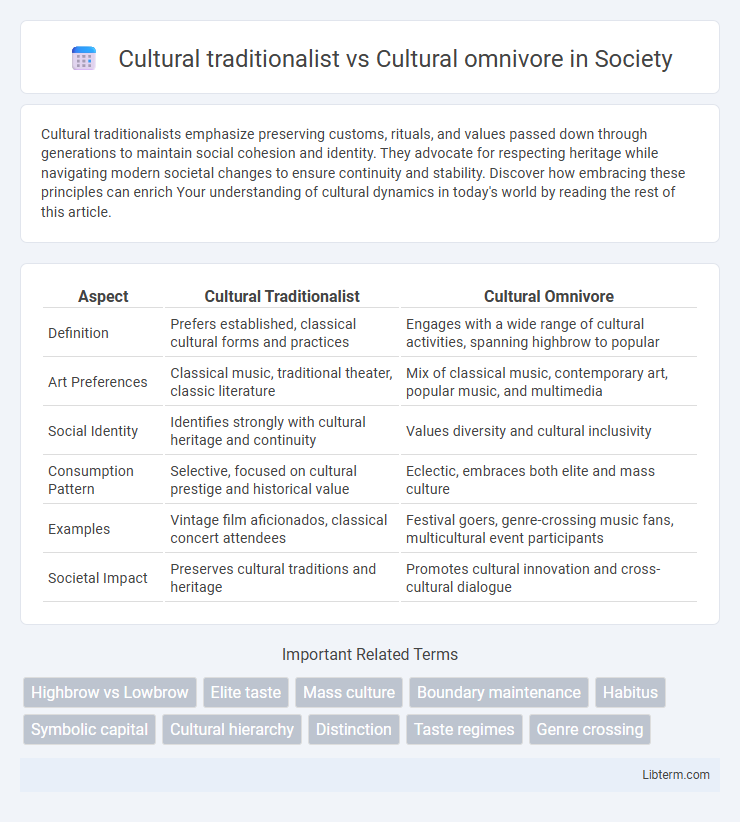Cultural traditionalists emphasize preserving customs, rituals, and values passed down through generations to maintain social cohesion and identity. They advocate for respecting heritage while navigating modern societal changes to ensure continuity and stability. Discover how embracing these principles can enrich Your understanding of cultural dynamics in today's world by reading the rest of this article.
Table of Comparison
| Aspect | Cultural Traditionalist | Cultural Omnivore |
|---|---|---|
| Definition | Prefers established, classical cultural forms and practices | Engages with a wide range of cultural activities, spanning highbrow to popular |
| Art Preferences | Classical music, traditional theater, classic literature | Mix of classical music, contemporary art, popular music, and multimedia |
| Social Identity | Identifies strongly with cultural heritage and continuity | Values diversity and cultural inclusivity |
| Consumption Pattern | Selective, focused on cultural prestige and historical value | Eclectic, embraces both elite and mass culture |
| Examples | Vintage film aficionados, classical concert attendees | Festival goers, genre-crossing music fans, multicultural event participants |
| Societal Impact | Preserves cultural traditions and heritage | Promotes cultural innovation and cross-cultural dialogue |
Understanding Cultural Traditionalism
Cultural traditionalism emphasizes preserving established customs, rituals, and heritage, valuing continuity and social cohesion within specific cultural contexts. It often prioritizes long-standing artistic expressions such as classical music, folk traditions, and canonical literature, reinforcing community identity and intergenerational transmission. Understanding cultural traditionalism reveals its role in maintaining societal stability and resisting rapid cultural change amid globalization pressures.
Defining the Cultural Omnivore
The Cultural Omnivore embraces a diverse range of cultural tastes, engaging with both highbrow and popular forms of art, music, and literature, contrasting with the Cultural Traditionalist who prefers elite, classical cultural experiences. This phenomenon highlights a shift in cultural consumption patterns where social status is signaled through varied cultural knowledge rather than exclusivity. Studies by sociologists like Richard A. Peterson emphasize how Cultural Omnivores break traditional boundaries by valuing inclusivity and eclecticism in cultural participation.
Historical Contexts of Cultural Consumption
Cultural traditionalists tend to consume classical and long-established cultural forms such as opera, classical music, and canonical literature, reflecting historical class-based distinctions dating back to the 19th and early 20th centuries. Cultural omnivores exhibit a broader spectrum of cultural consumption that includes both highbrow and popular cultural products, embodying a postmodern shift in the late 20th century toward embracing diversity and hybridity in cultural practices. This historical evolution highlights how socio-cultural dynamics influenced patterns of cultural engagement, with traditionalists maintaining elite cultural preferences and omnivores embracing inclusivity across genres and styles.
Key Characteristics of Traditionalists
Cultural traditionalists exhibit a strong preference for classical and long-established cultural forms such as classical music, opera, and traditional literature, often valuing heritage and historical continuity. Their cultural consumption tends to be exclusive, focusing on highbrow arts and rituals that reinforce social identity and cultural capital within established norms. Traditionalists prioritize preservation and authenticity, usually resisting contemporary or popular cultural trends in favor of time-honored practices.
Key Traits of Cultural Omnivores
Cultural omnivores exhibit a diverse range of interests across highbrow and popular cultural forms, embracing everything from classical music and fine arts to contemporary media and street culture. They tend to have a higher level of education and value cultural openness, adaptability, and inclusivity, contrasting with cultural traditionalists who prefer conventional, elite cultural expressions. This broad cultural consumption reflects their social versatility and tendency to challenge established cultural boundaries.
Societal Impacts of Both Approaches
Cultural traditionalists reinforce social cohesion by preserving established customs and fostering group identity, which can enhance community stability but may limit diversity and innovation. Cultural omnivores promote inclusivity and cross-cultural understanding by embracing diverse cultural expressions, driving social integration and broadening collective perspectives while potentially diluting distinctive traditions. Societal impacts of these approaches reflect tensions between cultural preservation and adaptability, influencing social dynamics, identity formation, and cultural evolution in multifaceted ways.
Cultural Hierarchies and Social Status
Cultural traditionalists tend to consume and value highbrow cultural forms such as classical music, fine art, and literature, often reinforcing existing cultural hierarchies that associate these forms with higher social status. Cultural omnivores, by contrast, embrace a diverse range of cultural tastes spanning both elite and popular forms, challenging traditional social stratifications and signaling cosmopolitanism. This omnivorous consumption pattern reflects a shift in social status markers from exclusive cultural capital to inclusive cultural diversity.
Globalization and Its Influence on Culture
Cultural traditionalists often resist globalization's influence, valuing the preservation of local customs and heritage against homogenizing global trends. In contrast, cultural omnivores embrace diverse influences, integrating global cultural elements into their lifestyles and exhibiting broad cultural consumption patterns. The interplay between globalization and culture creates a dynamic tension where traditionalism seeks cultural continuity, while omnivorousness fosters cultural hybridization and innovation.
Challenges in Bridging Cultural Perspectives
Cultural traditionalists often face challenges in embracing diverse cultural expressions, which can hinder cross-cultural understanding and social cohesion. Cultural omnivores, who actively engage with a wide range of cultural forms, may struggle to relate to traditionalists' emphasis on heritage and preservation, creating a divide in cultural values and practices. Overcoming these challenges requires fostering dialogue that respects both the preservation of cultural traditions and the inclusion of diverse cultural experiences to build mutual respect.
The Future of Cultural Identity
Cultural traditionalists emphasize preserving established customs and heritage, anchoring identity in longstanding rituals and values that resist rapid change. Cultural omnivores embrace diverse cultural expressions, blending global influences to create fluid and multifaceted identities adapting to dynamic social landscapes. The future of cultural identity hinges on balancing respect for historical roots with openness to evolving, hybrid cultural experiences that reflect globalization and digital interconnectedness.
Cultural traditionalist Infographic

 libterm.com
libterm.com